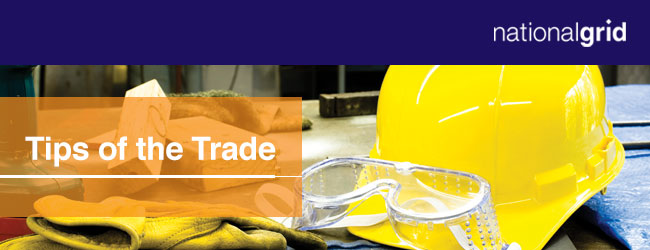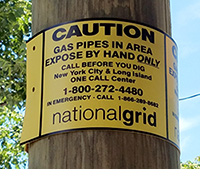
Natural gas pipeline markers
Welcome to National Grid’s Tips of the Trade. National Grid is committed to your safety, and these tips are intended to help you work safely near our facilities. Please review these tips with your coworkers at your tailgate or toolbox meetings before work begins.
Getting ready to dig?
Check for National Grid’s pipeline markers near your dig site. These markers are usually bright yellow and display our name and emergency phone number. If you see one, you’ll know a high-pressure natural gas transmission pipeline is nearby, and extra precautions are necessary. Pipeline markers call for extra careDamage to a high-pressure pipeline can cause a natural gas leak that results in a catastrophic fire or explosion. Prior to digging, excavators working within 20 feet of a high-pressure natural gas transmission pipeline are required to attend an onsite meeting and/or have contact with qualified National Grid representatives to help reduce the risk of excavation-related damage. National Grid MUST be onsite during the excavation. Never use pipeline markers as a substitute for calling 811By law, you must call 811 or enter an online request at least 72 hours before digging in Massachusetts and Rhode Island, and at least 48 hours before digging in New York, excluding weekends and legal holidays. Pipeline markers only indicate the general location of high-pressure gas transmission lines. They are not present in all areas, and for security reasons, they do not show the exact location, depth or number of gas pipelines in the area. Pipeline markers also do not show the location of distribution pipelines or service lines that carry natural gas to homes and businesses. And, pipelines do NOT follow a direct course between the markers. Where you’ll find pipeline markers
Signs of a high-pressure gas leakIf you observe suspicious activities or any signs of a natural gas leak near a pipeline marker, call the phone number listed on the marker. Signs of a high-pressure gas leak may include a distinctive, sulfur-like odor; a hissing, roaring or whistling sound; dirt spraying or blowing into the air from a hole in the ground; and continual bubbling in water. Would you like to know more?Additional overhead and digging guidelines, case studies, instructional videos and training tools can all be found, at no charge to you, on National Grid’s e-SMARTworkers website. Do you like this email series? Do you find the information helpful? We’d like to know. Please reply to this email and tell us what you think, or let us know what topics you’d like to see in future emails. For more contractor safety information, visit ngridsafety.com. |
|||||||||
 |
Smell Gas. Act Fast. |
||||||||
Call 811 or enter an online request at least 72 hours before digging in Massachusetts and Rhode Island, and at least 48 hours in New York, excluding weekends and legal holidays:
| |||||||||
|
|||||||||
| #10764 |

 Pipeline markers are usually found where a high-pressure pipeline intersects a highway, street or railway and at other readily visible points along a pipeline right of way (ROW). A ROW is a corridor of land clear of trees, buildings or other structures—for example, alongside a railroad track.
Pipeline markers are usually found where a high-pressure pipeline intersects a highway, street or railway and at other readily visible points along a pipeline right of way (ROW). A ROW is a corridor of land clear of trees, buildings or other structures—for example, alongside a railroad track.